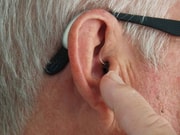
Hearing loss doesn’t always arrive with a dramatic moment—it often tiptoes in quietly, reshaping everyday life in ways we barely notice at first.
Maybe you’ve caught yourself smiling and nodding through a conversation you couldn’t quite follow, or asking someone to repeat themselves in a crowded café while pretending you heard the first time. Maybe the TV volume creeps up a notch every few months, or family dinners feel more exhausting than engaging.
If any of that sounds familiar, you’re not alone—and you’re not imagining it.
Hearing changes are common, especially as we age, and they can affect how we connect, communicate, and feel in social spaces.
The good news? Over-the-counter (OTC) hearing aids are more accessible than ever, and here at The GrayVine, we believe in empowering you with the knowledge to make confident, informed decisions.
So, let’s dive into the five crucial facts you need to know before buying OTC hearing aids—plus a few extra tips and real-life wisdom to help you hear (and live) your best.
1. Is an OTC hearing aid right for your type of hearing loss?
OTC hearing aids are designed for adults with mild to moderate hearing loss. This typically means you can follow one-on-one conversations in quiet settings but start to miss words when background noise is present. If that sounds like you—able to keep up at home but struggling in busy restaurants—OTC devices might be a suitable option.
However, if you’re having difficulty hearing even in silence, or if you experience sudden hearing loss, ear pain, drainage, dizziness, or hearing loss in just one ear, it’s important to seek medical attention. These symptoms could indicate a more serious condition that requires professional care.
Not sure where you fall on the spectrum? Some OTC hearing aid brands offer online screening tools to give you a general sense of your hearing ability. In addition, assessments like the Hearing Handicap Inventory and the Consumer Ear Disease Risk Assessment can provide a helpful starting point.
Still, the most accurate way to understand your hearing health is by consulting an audiologist or an ear, nose, and throat (ENT) specialist.
Early evaluation can help preserve your ability to understand speech over time—so if you’re uncertain, don’t wait to get checked.
2. How much setup support will you need?
This is where being tech-savvy can make a difference.
Certain OTC hearing aids connect with smartphone apps that guide users through a simple hearing check and offer personalized sound adjustments. Others are ready to use right out of the box, with preset modes tailored for everyday environments like quiet chats or noisy dining spots.
Traditionally, hearing aids have been purchased through audiologists or specialized hearing clinics. In fact, a February 2025 survey of older adults found that 65% had obtained their devices this way.
But that trend is shifting, as more people realize they can access reliable hearing aids without the need for repeated in-person appointments.
Many manufacturers now offer phone support from trained representatives, and some local audiologists will help set up OTC devices for a fee. The key is being honest about your comfort level with technology and your willingness to troubleshoot on your own.
3. Which features will actually make a difference in your daily life?
Your lifestyle should drive your choice, not the latest bells and whistles.
If you're active and social, look for devices with strong background noise reduction and directional microphones that help you focus on the person speaking in front of you.
For those who prefer quieter environments, prioritize comfort and natural sound quality over advanced noise-canceling features. Behind-the-ear models are often easier to handle for those with dexterity issues, while in-the-ear models offer discretion.
Battery life varies significantly between models. Rechargeable hearing aids typically provide a full day of use, and many include charging cases that can recharge the devices multiple times before needing to be plugged in themselves.
Also read: Silence the ring: Why your ear is ringing and 6 habits to stop now.
4. How will battery life fit into your routine?
Battery life plays a big role in how well your hearing aids fit into daily life.
Rechargeable models are gaining popularity for good reason—they typically last all day and often come with charging cases that hold enough power for several days.
If you travel frequently or tend to forget to plug in your devices, look for options with extended battery life and easy-to-read indicators.
Disposable batteries are still widely used, but they need regular replacement and can be tricky to handle, especially for those with limited dexterity.
The key is to match your power source to your routine. If you're constantly on the move, a rechargeable device with a multi-day case can be a game-changer. If you spend most of your time at home, disposable batteries may work just fine—just be sure to keep extras within reach so you're never caught without sound.
5. What protections and costs should you expect?
OTC hearing aids come in a wide range—from simple, budget-friendly options to high-tech models with premium price tags. But a higher cost doesn’t always mean a better match. What matters most is choosing features that suit your lifestyle and hearing needs.
Before committing, check for a generous trial or return policy (ideally 30 days) so you can test the device in everyday situations. A solid manufacturer warranty should cover defects for at least a year.
During your trial, keep a journal to track when sounds feel unclear, uncomfortable, or when the battery runs out. These notes can help you fine-tune settings, swap out ear tips, or decide if a different model would work better.
Give yourself two to three weeks to adjust. Start by using your hearing aids at home, then gradually introduce them to noisier or more complex environments. If things still don’t feel right after a few tweaks, don’t hesitate to return or exchange them. Your comfort and ability to hear clearly should always come first.
Bonus tips for a smooth transition
- Be patient: Your brain needs time to adjust to new sounds. Don’t give up if things feel strange at first.
- Ask for help: Don’t be shy about reaching out to customer support or a local audiologist if you need guidance.
- Watch for red flags: If you experience pain, drainage, sudden changes in hearing, or dizziness, stop using the device and contact a healthcare professional.
Choosing the right OTC hearing aid is about more than just price or brand—it’s about matching your unique hearing needs, lifestyle, and comfort level with the right features and support.
Take your time, do your homework, and don’t be afraid to ask questions or seek help. With the right device, you can rediscover the joy of conversation, laughter, and all the sounds that make life rich.
Have you tried OTC hearing aids? What features made the biggest difference for you? Do you have tips for others just starting their hearing journey? Share your experiences, questions, or advice in the comments below—your story could help someone else hear the world a little more clearly.
At The GrayVine, we’re all ears—so let’s keep the conversation going!






